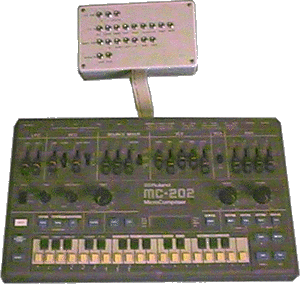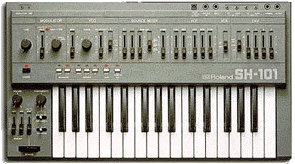
Roland MC-202 MicroComposer

Type:
Analog Monophonic Synth
+ CV Sequencer
Design: Japan
Year: 1982
Price: about
400 USD/EUR (used/1998)
| User Interface: | |
| Editing Features: | |
| Sound Quality: | |
| Price / Performance: |
![]()
I actually got this unit via my boss at work who had it in it's cellar for 6 years !!! He bought it back in 1984 as a cheap alternative for a home synth while his friends had invested on much more expensive (and professional) Arp and Moog's.... Later he got an Korg M-1 and this cute little module got lost in the cellar... After seeing my interest for such a "oldie synth" he simply accepted to give it to me for free, arguing that anyway he was too old to get crappy and weird sounds out of it......
Whatever the story THIS IS PROBABLY MY WEIRDEST AND GRUNGIEST SYNTH !
Really great when it comes to get powerful and heratic basses but it is used at it's best with plenty of modulation and high resonance settings. Weird sweepy and brillant sounds comes up when the filter goes into self-oscillation. Definitively much more versatile than a TB with it's VCO mixer, LFO and complete ADSR, this unit is in no matter a 303 or any acid unit: it looks like, feels like, works like (and sometimes smells like...) but it has it's own and unique sound due to its mighty CEM VCO's and it's 24db 4 pole Filter.
I've decided to upgrade it heavily in order to control it via MIDI: I 've implemented a expansion box giving 21 CV sockets coming from inside the beast. It's actually something really ugly but I've used the 202 as a small modular since them...
![]()
| Module | Controls | Comments |
| LFO | Rate Delay LED Indicator |
Triangle LFO with delay time being VERY long if you put it at 100%. |
| VCO | Ptch range: 16', 8', 4', 2' Pitch Modulation Pulse Width Modulation PW Modulation source: LFO, Manual or Env |
Only 1 VCO using a CEM Chip |
| Mixer | VCO Square output VCO Saw Output VCO Sub-oscillator Output Sub-Oscillator Type: -1 Oct Square -2 Oct Square -2 Oct Square with Pulse Width. |
The VCO ouputs simultaneously Square, Saw and Sub voices via the mixer. |
| VCF | Cutoff Frequency Resonance Envelope Modulation LFO Modulation Keyboard Tracking |
A 24db/octave 4-pole Filter which runs into self-oscillation at 75% of it's resonance setting. Really screams in that mode..... |
| VCA | VCA mode: Envelope or Gate | Gate boosts real hard your output. |
| Envelope | Attack Decay Sustain Release |
Classic ADSR but with really long response time if you go up to 100%. Better stay in the first 25%. |
| Main controls | Tune Porta Accent Main Volume |
Very long porta Time compared to a 303. Gets really weird if you
go all the way up. Accent can affect VCF and VCA |
| Sequencer | 2000 or so steps pattern memory. Mini rubber keyboard w/ transpose +/- 1 oct. Tempo from Slow (40?) to Fast (240?) Legato Mode VCF/VCA Accent assign Step by step and real time recording. LCD screen to get a glimpse at where you are lost....... anyway much better than a 303....... |
Quite similar to the TB step by step programming procedure but
with much more flexibility with the VCF and VCA accents and editing possibilities. Best used as random programming because once you've made a mistake it's almost impossible to get rid of it... |
| In / Outs | DIN Sync: 1 In, 2 Out External Tape Backup: 1 In, 1 Out CV Gate: 1 In, 2 Out Audio: Main Out, Phones Out |
The Phones out can be used as a second main output (Auxilliary) Din Sync and CV Gate layout can be very useful to control vintage Roland Gear (Juno and TR types) |
![]()
![]() Additional
Modifications and upgrade:
Additional
Modifications and upgrade:

All these upgrades consist in opening the 202 casing and soldering some 21 sockets to the mainboard to access vital components like CV Voltages and Audio signal. All these sockets are mounted on a seperate casing linked to the 202 via a ribbon cable.
Once done, the only thing you need are leads to plug into the audio signal and an external CV Controller to deliver CV controls via MIDI. I use the Peavey PC-1600 to issue MIDI Controller messages passed on over to CV by the TeeBee MkIII Module and the Paia MIDI2CV8 Kit.
| Module upgrade | Sockets | Comments |
| Control Voltage CV Out (Top three jacks) |
Envelope Out Triangle LFO Out Sine LFO Out |
From within the 202 the original LFO signal is Sine. You can get it out as well as the Triangle LFO CV to plug it into another synth synced on the same LFO. |
| Control Voltage CV In (Second 9 jacks) |
Pitch CV In Gate CV Pulse Width Modulation VCF Cutoff VCA Volume VCF Accent On / Off VCA Accent On / Off Portamento On / Off Pitch Mod |
Pitch and Gate CV sockets overide the 202 sequencing
processor (thus loosing it) but permits smooth pitch bend. On /Off CV's are cool features to trigger via midi Porta or accent. Other control CV permits Almost totakl control over the 202's main features. |
| Audio Out (Third 7 jacks) |
VCO Saw Out VCO Square Out VCO Sub -1 Out VCO Sub -2 Out VCO Sub -2 w/ PW Out VCO Mixer Out VCA Out |
Individual VCO out's are fantastic to feed other
external Filters or Synth's allowing VCF input. CEM Chips for everybody at hand... |
| Audio In (Bottom 2 jacks) |
VCF In VCA In |
These allow to overdrive the filter or to add feedback in the VCA by pluging in the phones out for instance. Ringmod type sounds are even possible. |
![]()
| Roland SH-101 |
 |
| The SH101 and the MC-202 shares many common features since much
of the two units have been co-developped by the same Roland's engineers. The SH-101 was
designed to be the live performance keyboard while it's cousin the MC-202 was more
designed for the amateur home-studio market which badly needed a CV/gate sequencer. The SH-101 has the same color scheme (grey with blue and black buttons). It has an additional noise source, LFO and pitch bend lever, a real keyboard (not a fake rubber one...) and a arpeggiator to spice up your tunes. On the other hand, it lacks the internal sequencer and the associated connectors of the MC-202. Aside all these, the sound sources and it's component layout is EXACTLY the same and the two produces actually the same type of sounds (minus the Noise source for the 202). Anyway the MC-202 is more compact and cheaper than a SH-101 and fits well into a studio setup, specially if you have to control old CV/gate gear. Pick one and choose, you won't be disappointed by either trip... |